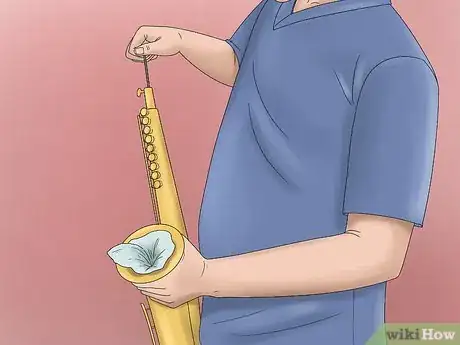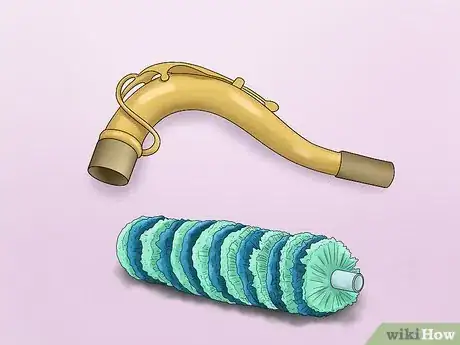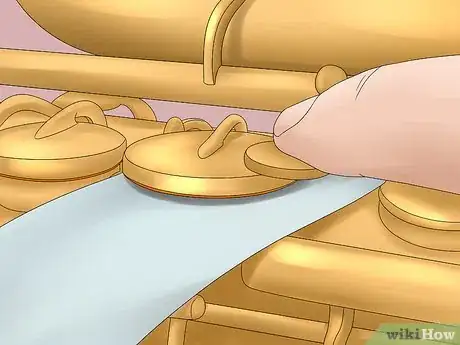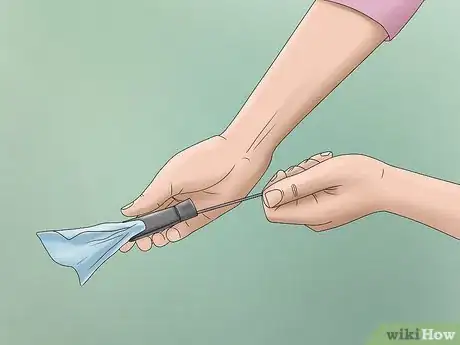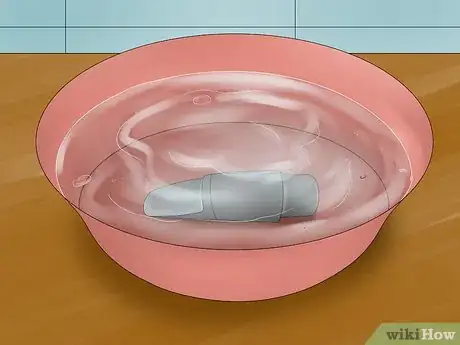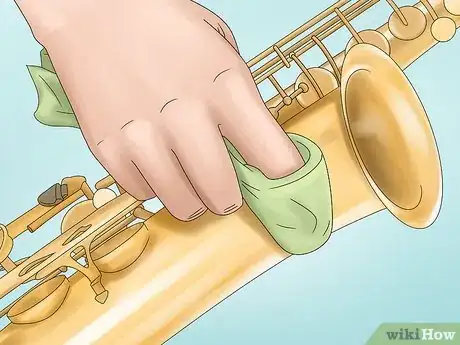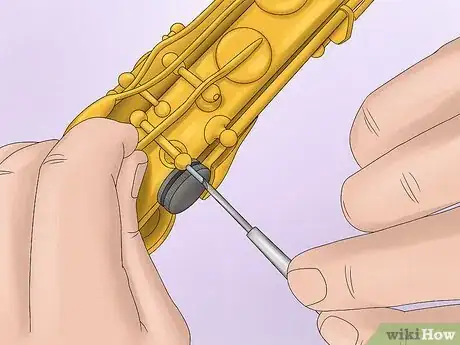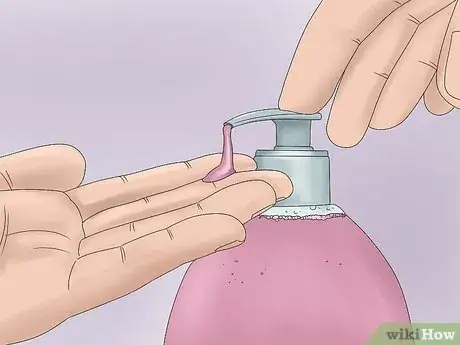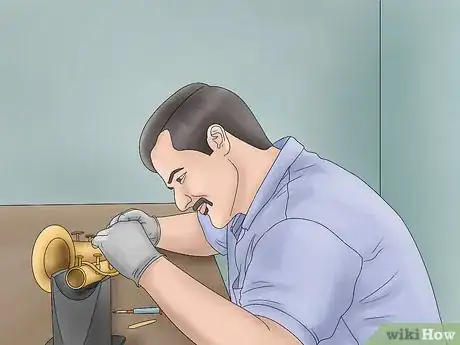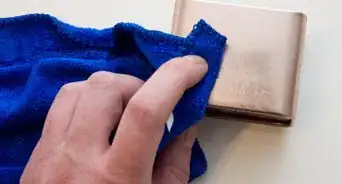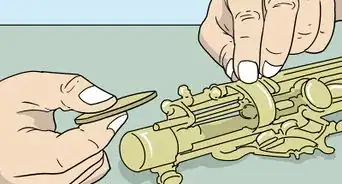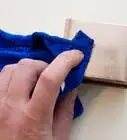This article was co-authored by wikiHow Staff. Our trained team of editors and researchers validate articles for accuracy and comprehensiveness. wikiHow's Content Management Team carefully monitors the work from our editorial staff to ensure that each article is backed by trusted research and meets our high quality standards.
There are 10 references cited in this article, which can be found at the bottom of the page.
wikiHow marks an article as reader-approved once it receives enough positive feedback. In this case, 90% of readers who voted found the article helpful, earning it our reader-approved status.
This article has been viewed 376,541 times.
Learn more...
Regular saxophone maintenance will keep both you and your instrument healthy, and can help prevent costly repairs. Cleaning your saxophone is a relatively simple process, provided your saxophone is the standard, half-bell shape. A saxophone cleaning kit is a smart investment that will save you a lot of time and effort.
Steps
Cleaning the Interior
-
1Swab the body. Most saxophone cleaning kits come with a brush or cloth on a long string with a weight on the opposite end. Put the weighted end into the bell of the saxophone and turn the sax upside down. Bring the weighted end through the body and come out the narrow end. Gently pull the swab through the body several times.[1]
- Swabbing helps dry the interior so that pads are not damaged, inhibits bacteria growth, and removes any build-up of foreign particles from foods, beverages or saliva in the instrument.[2]
- It is not unusual to see a slight green color on the pad after a few passes. This is normal and does not indicate rust or metal damage.[3]
-
2Swab the neck. Insert a flexible swab through the larger base opening on the neck, coming out on the narrow side to which the cork is attached. Brush out the inside thoroughly to remove any foreign particles.
- You can run water through the neck as well — just be sure that no water comes in contact with the cork, or it may swell and deform.
- Soaking with vinegar or brushing with detergent can help get rid of excess build-up.[4]
Advertisement -
3Use a pad saver. If available, these are helpful for removing any residual moisture. Make sure to use them after swabbing. Insert the pad saver through the body's narrow end. Let it absorb moisture for a few seconds, then remove.[5]
- Some manufacturers make similar items such as "bell brushes" or "neck savers" for other parts of the saxophone. These are fine to use similarly if you have them, but not necessary for regular saxophone maintenance.
-
4Inspect & clean the key pads. Check for sticky pads as you play the saxophone, and visually inspect under the pads for any wear and tear. Use wet cotton swabs or a thin piece of paper to clean where the pads meet the tone, removing any sticky residue. A little clean water should be enough to do the job.
Cleaning the Mouthpiece
-
1Clean your mouthpiece's interior. You'll want to clean the mouthpiece often, as it comes into contact with your mouth. Start out by removing the reed, then use a mouthpiece brush to remove any residue inside the mouthpiece. You can substitute a bottle brush or even a small toothbrush. Run cold or lukewarm water through the mouthpiece, then pull a clean, lint-free cloth through the mouthpiece to dry and remove any particles missed by the brush.
- Soaking in antiseptic mouthwash or detergent is helpful for particularly dirty mouthpieces.[6]
-
2Sand out scratches. If you'd like to save a rubber or resin mouthpiece with light marks, use sandpaper or a fingernail sanding block. Start with the coarsest grit to remove the scratch. Progress to increasingly fine grits to smooth the mouthpiece out.[7]
-
3Clean the reed. The warm air you blow into it contains saliva, which provides a moist place for bacterial and fungal growth as well as food particles that damage the instrument.[8] Wipe it down thoroughly after each use with a clean towel or cotton swab. This will stop bacteria and chemicals from congealing.[9]
-
4
Finishing Up
-
1
-
2Tighten loose screws. You can safely tighten loose rod screws, but be careful not to over-torque them.[14]
-
3Clean your cleaners. Specialty swabs, pad savers and bell brushes can be washed lightly by hand with a small amount of soap. Each should last years if cleaned regularly.[15]
-
4Reassemble your saxophone. It should look, feel, and play beautifully! When in doubt, consult a professional.
Community Q&A
-
QuestionWhy does my alto saxophone keep sounding off?
 Community AnswerThere are a few possibilities. You might be pressing a button and not noticing, and or your saxophone is not being properly tuned. If it's sounding low, push your mouth peace in; if it's too high, pull it out. Also, check to make sure that your bottom lip is tucked in between your mouth and mouthpiece when you play.
Community AnswerThere are a few possibilities. You might be pressing a button and not noticing, and or your saxophone is not being properly tuned. If it's sounding low, push your mouth peace in; if it's too high, pull it out. Also, check to make sure that your bottom lip is tucked in between your mouth and mouthpiece when you play. -
QuestionMy cork has mold inside of it. How do I get it out?
 Community AnswerYou should have the cork removed and replaced. In the future, regularly clean the new cork, because mold is harmful and difficult to remove.
Community AnswerYou should have the cork removed and replaced. In the future, regularly clean the new cork, because mold is harmful and difficult to remove. -
QuestionDo I need to take out my mouth piece when your done each time?
 Community AnswerEvery time you're done playing you should completely take apart your sax. For cleaning you need to to clean all the parts.
Community AnswerEvery time you're done playing you should completely take apart your sax. For cleaning you need to to clean all the parts.
Warnings
- Do not attempt to oil, remove dents, replace pads, or use scratch-removers on the finish of your saxophone. Leave these things to a professional. If you have a rental instrument, in most cases these services are performed free of charge.⧼thumbs_response⧽
- Never try to apply key oil to your saxophone or any woodwind. If you need your keys to be oiled, take your saxophone to a professional.⧼thumbs_response⧽
- Never put your saxophone in water. If you ever do it can ruin the pads on your instrument and the cork that's on it too.⧼thumbs_response⧽
References
- ↑ https://www.youtube.com/watch?v=_gr2mFi7I3k
- ↑ http://www.shinemusic.com.au/musicresources/maintain-saxophone.aspx
- ↑ http://www.shinemusic.com.au/musicresources/maintain-saxophone.aspx
- ↑ https://tamingthesaxophone.com/saxophone-maintenance-cleaning
- ↑ https://www.youtube.com/watch?v=Yk9zTjwGhmM
- ↑ http://www.shinemusic.com.au/musicresources/maintain-saxophone.aspx
- ↑ https://tamingthesaxophone.com/saxophone-mouthpiece-cleaning
- ↑ https://www.nemc.com/instrument-care-instructions/saxophone-care
- ↑ https://tamingthesaxophone.com/saxophone-mouthpiece-cleaning
- ↑ https://tamingthesaxophone.com/saxophone-mouthpiece-cleaning
- ↑ http://www.gobassoon.com/reed-care.html
- ↑ http://www.saxophone-guy.com/saxophone-care-and-maintenance.html
- ↑ http://mellowood.ca/music/essays/saxclean.html
- ↑ http://www.shinemusic.com.au/musicresources/maintain-saxophone.aspx
- ↑ https://www.youtube.com/watch?v=q37KVFIliNE
About This Article
To clean a saxophone, start by wiping out the body using the brush or cloth that comes with your cleaning kit. Next, put a flexible swab through the neck and brush out the insides. After swabbing, insert a pad saver to remove any residual moisture. Then, to clean the mouthpiece, detach the reed and use a brush to remove any residue, or run cold water through the mouthpiece and pull a clean cloth through it. If the mouthpiece is especially dirty, soak it in water and detergent. Finally, disinfect the reed by soaking it in alcohol or mouthwash. To learn how to polish the body of your saxophone, keep reading!
